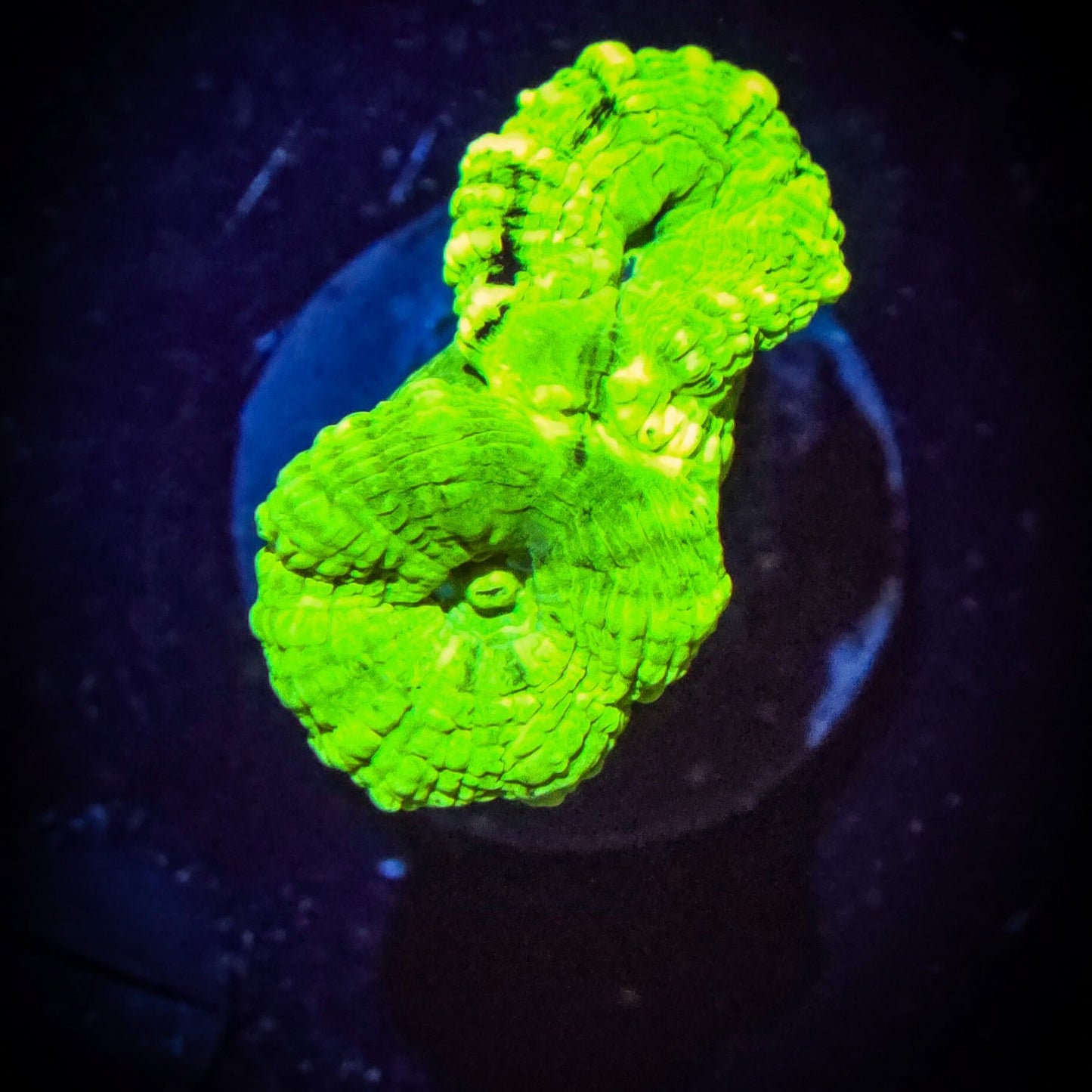
Description
Review
FAQ
Candy Cane Coral, also known as Caulastrea furcata, is a popular large polyp stony (LPS) coral. It is well-loved in the reef aquarium community for its vibrant colors, relatively easy care, and distinctive trumpet-like polyps. Candy Cane Coral is an excellent choice for both beginner and experienced reef-keepers.
Candy Cane Corals have thick, fleshy polyps that form trumpet-shaped heads. Each polyp has a central mouth surrounded by a ring of vibrant colors, often green, blue, brown, or purple, with a contrasting fluorescent stripe or outline. The coral skeleton is rigid and branches out, creating clusters of polyps that can expand beautifully in a reef tank.
Lighting: Candy Cane Corals prefer moderate lighting. They can adapt to a range of lighting conditions, from lower to higher light, but typically display their best colors under medium intensity. Place the coral in an area of the tank where it can receive adequate light without being exposed to extremely bright or direct light. If your lighting is very strong, consider placing it lower in the tank or in a slightly shaded area.
Flow: Moderate water flow is ideal. The flow should be enough to gently move the coral’s tentacles but not so strong that it causes the polyps to retract or get damaged. The right amount of flow will also help remove debris from the coral and promote gas exchange.
Parameters: Temp 75°F to 80°F (24°C to 27°C), Salinity 1.024 to 1.026 specific gravity, pH 8.1 to 8.4, Alk 8 to 10 dKH, Calcium 400 to 450 ppm, Mag 1250 to 1350 ppm
Feeding: Although Candy Cane Corals contain photosynthetic zooxanthellae, they benefit greatly from supplemental feeding, which can enhance their growth and coloration. Offer meaty foods such as brine shrimp, mysis shrimp, and finely chopped seafood. Reef-specific coral foods, like microplankton and coral pellets, are also beneficial.
While they are not aggressive, Candy Cane Corals can suffer from stings by other LPS or SPS corals that may have longer-reaching tentacles. Make sure to give them enough room to grow and expand without competition.
This is a representative picture of the piece of coral you will receive not the exact piece of coral you will receive (almost WYSIWYG).
Description
Candy Cane Coral, also known as Caulastrea furcata, is a popular large polyp stony (LPS) coral. It is well-loved in the reef aquarium community for its vibrant colors, relatively easy care, and distinctive trumpet-like polyps. Candy Cane Coral is an excellent choice for both beginner and experienced reef-keepers.
Candy Cane Corals have thick, fleshy polyps that form trumpet-shaped heads. Each polyp has a central mouth surrounded by a ring of vibrant colors, often green, blue, brown, or purple, with a contrasting fluorescent stripe or outline. The coral skeleton is rigid and branches out, creating clusters of polyps that can expand beautifully in a reef tank.
Lighting: Candy Cane Corals prefer moderate lighting. They can adapt to a range of lighting conditions, from lower to higher light, but typically display their best colors under medium intensity. Place the coral in an area of the tank where it can receive adequate light without being exposed to extremely bright or direct light. If your lighting is very strong, consider placing it lower in the tank or in a slightly shaded area.
Flow: Moderate water flow is ideal. The flow should be enough to gently move the coral’s tentacles but not so strong that it causes the polyps to retract or get damaged. The right amount of flow will also help remove debris from the coral and promote gas exchange.
Parameters: Temp 75°F to 80°F (24°C to 27°C), Salinity 1.024 to 1.026 specific gravity, pH 8.1 to 8.4, Alk 8 to 10 dKH, Calcium 400 to 450 ppm, Mag 1250 to 1350 ppm
Feeding: Although Candy Cane Corals contain photosynthetic zooxanthellae, they benefit greatly from supplemental feeding, which can enhance their growth and coloration. Offer meaty foods such as brine shrimp, mysis shrimp, and finely chopped seafood. Reef-specific coral foods, like microplankton and coral pellets, are also beneficial.
While they are not aggressive, Candy Cane Corals can suffer from stings by other LPS or SPS corals that may have longer-reaching tentacles. Make sure to give them enough room to grow and expand without competition.
This is a representative picture of the piece of coral you will receive not the exact piece of coral you will receive (almost WYSIWYG).
Review
FAQ

